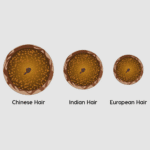Choosing the hair type for wigs is one of the most important decisions you make. You’ll have to decide between human vs. synthetic hair. Each hair type comes with its benefits and is ideal for wigs to conceal hair loss. Hairstylists typically choose to stock both options for their clients to give them a variety of choices.
While human hair gives you a seamless and natural finish, synthetic hair is more affordable as an entry-level product in the wig industry. Many clients jump between the two or choose to stick to syntenic or human hair. Before you start shopping for a wig, you want to choose your preferred hair type.
Keep reading to find perks of each hair type and how to tell the difference between synthetic vs. human hair .
- Related: Comparison of European Hair, Indian Hair, and Chinese Hair
- Related: Virgin Hair vs. Remy Hair vs. Non-Remy Hair: What are the Differences?
- Related: Where Does Human Hair Come From For Wigs?
What is Synthetic Hair?
Whatever type of hair you’re looking for, synthetic hair is guaranteed to provide it. You’ll find synthetic hair with every type of characteristic – from glossiness to feels and different weights. Kanekalon is the most popular synthetic fiber used for hairpieces, especially women’s wigs and hair extensions. Most synthetic hair is produced in China, Korea, and Japan.
Synthetic hair has been overlooked in the past because it was previously made using machines that created cheap and unnatural-looking wigs. Thanks to recent innovations in the hair system industry, the quality of synthetic hair has improved to rival that of human hair. Synthetic hair now has the appearance of natural human hair to give you a seamless look without the price tag of human hair.
What is Human Hair?
Human hair typically falls into several categories, including Brazilian, European, Chinese, Indian, and Mongolian hair. Just like synthetic hair, every type of human hair has its own characteristics that give it a unique character.
The most popular type of human hair is Indian Remy hair due to its durability and resilience. It’s also ideal for creating a wig that has a natural lift effect for a voluminous look.
Brazilian and Indian hair is thinner but has a softer finish that is ideal for hairpieces that have a wavy finish.
Chinese hair and Mongolia hair are thick and strong, normally used for wigs with high density.
The most expensive and desirable type of human hair is European hair, which is ideal for clients looking for a flat effect on their wigs. You’ll primarily see European hair is used for hair extensions for clients in the European and American markets who want an effortless finish to their hair systems.
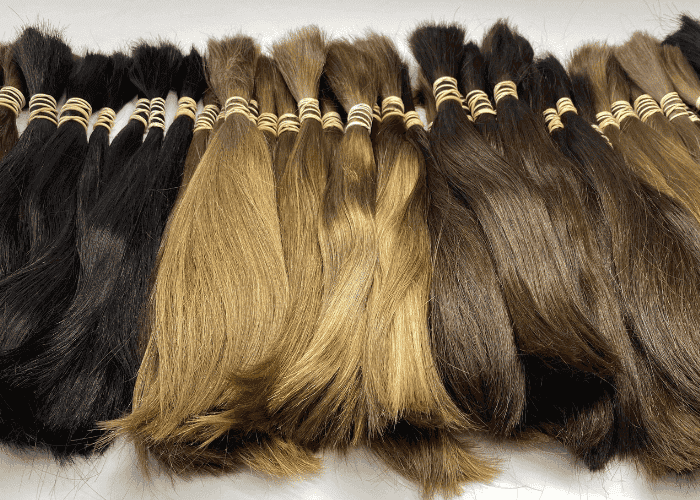
Once human hair has gone through an acid treatment, it can be tailored to your preferred style. Whether you’re looking for bleached, curled, or dyed hair, you can have any look you want with human hair.
Every human hair type has its benefits and will work for a specific client. As a hairstylist or salon owner, you want to help your client find the right hair type for their wig or hair system. Whichever way they choose on the synthetic vs. human hair debate, every client is guaranteed to find a hair type that works for their needs.
Different Types of Human Hair
Along with ethnicity, human hair is also divided into three further categories. Virgin, Remy, and normal hair. You can take advantage of a wider range of options for your human hair, allowing you to create a seamless hair toupee that works with your natural hair.
It’s important to differentiate how your natural hair is different. Your natural hair maintains its cuticles which are in the same direction to prevent tangles from happening constantly.
Remy hair has its cuticles in the same direction and has previously been chemically treated. Remy hair may originally have been ‘virgin’ hair before being chemically treated to meet a client’s specific needs.
By comparison, virgin hair has cuticles that face the same direction and is hair that has never been dyed or chemically treated – hence why it is called ‘virgin’ hair. It’s the most expensive option when you consider synthetic hair vs. human hair.
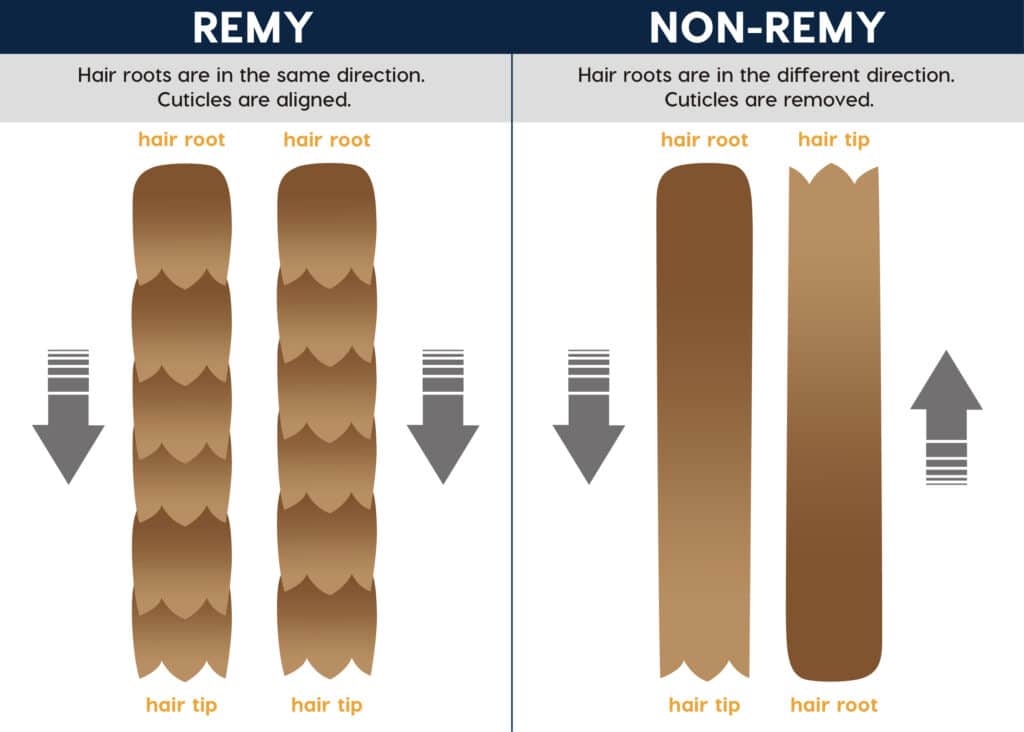
Non-Remy hair, also known as normal hair, has an inconsistent appearance and doesn’t have the smoothness of virgin human hair. It has a shorter lifespan than other human hair types and is thinner for a lightweight toupee or wig.
Synthetic Hair vs. Human Hair: What Are the Differences?
To the naked eye, it can be difficult to tell the difference between synthetic vs. human hair. Unless you’re a hairstylist or expert, you likely won’t be able to tell the difference unless you’re up close and personal with the hairpiece.
The difference between synthetic hair and human hair is often why clients end up preferring one type over the other for their toupee. Neither is a bad option, and both have their benefits. We’re rounding up some of the differences between synthetic hair vs. human hair so that you decide which one works best for you or your client.
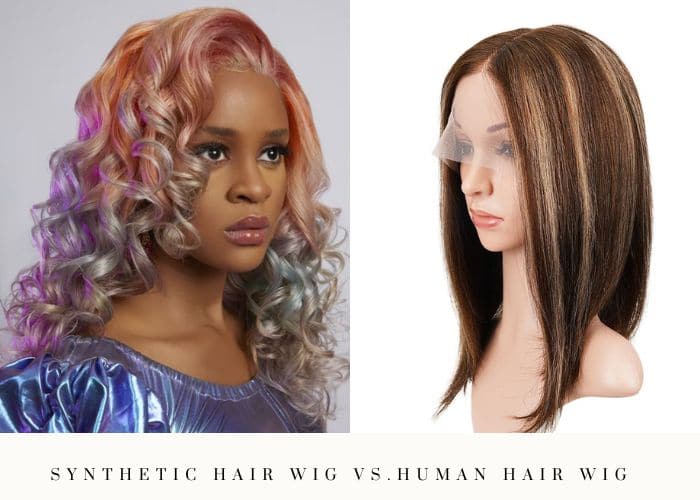
1. The price difference between synthetic and human hair
The most obvious difference between synthetic vs. human hair is the price difference. Synthetic hair wigs are at a more attainable price point than their human hair counterparts. The cost of human hair continues to rise as it becomes harder to find untreated human hair. As this is a problem that synthetic hair doesn’t face, it has a more consistent and attainable price point.
If you want a luxury hair system with the most natural finish, a human hair system is the right choice for you. Although synthetic hair sits at a more budget-friendly price point, it can be a better choice for your specific needs to choose a human hair system.
2. The touch and feel of each hair type
The difference between syntenic and human hair also lies in the touch and feel. Synthetic hair doesn’t have the same softness and smoothness as human hair, and it’s mainly noticeable when brushing. This difference is noticeable even with high-quality synthetic hair.
When you look closely at synthetic hair vs. human hair, you’ll notice the difference in the fibers. The plastic fibers of synthetic hair systems are pulled and stretched through a narrower hole, leaving behind more twists in the hair. By comparison, human hair has a protein structure that is smoother and doesn’t go through as much strain as synthetic hair.
Overall, human hair wigs are more comfortable to wear. If you’re intending to wear the wig every day, human hair wigs are a better option.
3. How long they can last
Human hair wigs can last a year or even more with good maintenance whereas synthetic hair can last for only 4-6 months with daily wear.
Over time, human hair will start to fade as it loses its natural shine and luster. On the other hand, synthetic fiber won’t fade as it is chemically treated to maintain the same appearance as when you first got it.
4. What you can do with your human or synthetic hair system
In practical terms, your hair type will determine what you can do with your wig.
With human hair, you have the flexibility to dye or treat the hairpiece. You won’t get this flexibility with a synthetic hair system as it can’t be re-dyed after it is originally dyed to meet the client’s preferences.
However, it’s also harder to style human hair than synthetic hair. With synthetic hair, it’s chemically treated to make it easier to work with when styling. If you’re looking to regularly curl or style the wig, synthetic hair might be the perfect choice for you. Wearing a synthetic hair wig can help protect your natural hair and reduce damage if you regularly use heat products to style your hair.
How to Tell the Difference Between Synthetic vs. Human Hair
If you’re new to the wig industry or shopping for wigs for the first time, you need to know how to distinguish between synthetic hair vs. human hair.
The gloss is usually the easiest way to tell the difference between the two hair types. Synthetic hair systems have a brighter gloss to them, while their human hair counterparts have a natural sheen. If you look at both hair wigs under bright light, synthetic hair will appear more artificial.
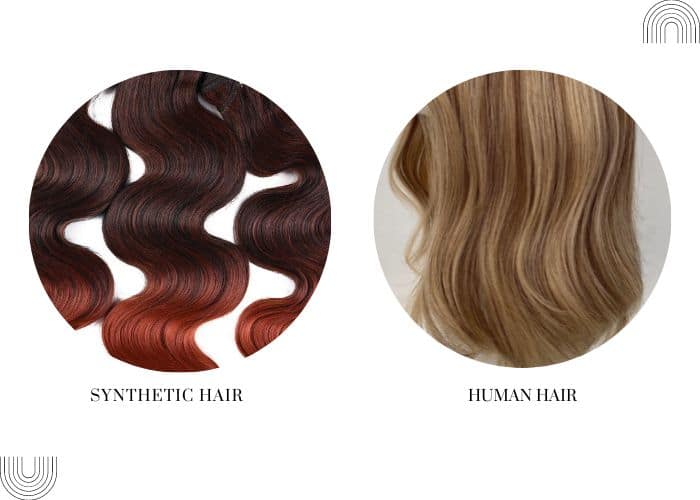
When you hold these two different hair types in your hand, you can also tell the difference between synthetic vs. human hair. Just like your own hair, human hair is luxurious with a soft and smooth feel. You’ll notice that synthetic hair has a harder consistency and can turn into a knot. When you’re wearing a synthetic hair system, you’ll notice that it begins to roll up over time.
A fool-proof way to tell if a hair system is made using synthetic or human hair is to put it under a hairdryer at its highest temperature. Human hair will behave like your own hair, while synthetic hair starts to deform and become fluffy the longer it is under the hairdryer.
If you’re able to, you can tell the difference between synthetic hair and human hair by using a lighter with a few hairs from the wig. Human hair will burn in a similar way to wool and becomes like a powder. When you do the same test with synthetic hair, it will smell like burning plastic with a pungent scent and form knots after burning.
Takeaway: Should You Choose Synthetic or Human Hair Wigs?
Both synthetic and human wigs have their pros and cons. When you’re deciding which one works best for you or your client, you need to consider the lifestyle preferences of the wearer.
A human hair wig is ideal for someone who wants a natural look and the flexibility to dye their hair system. If you’re prioritizing the feel and look of your wig, human hair will tick all the boxes for you. With human hair, you can personalize your wig or toupee by choosing the specific hair type that you want.
By comparison, synthetic hair is an ideal choice for anyone who wants to style their hair regularly and take advantage of a more attainable price point.
Whether you’re buying a hair system for yourself or a client, sit down and write out a list of your top priorities. This list will help you narrow down different hair types and find your preferred hair type for your hairpiece.
Have you got a question about synthetic vs. human hair? You can reach out to our customer service team at info@newtimeshair.com to help you find the right hairpieces for you or your clients.
Visit our wholesale human hair wig collection to explore our human hair wig options!




